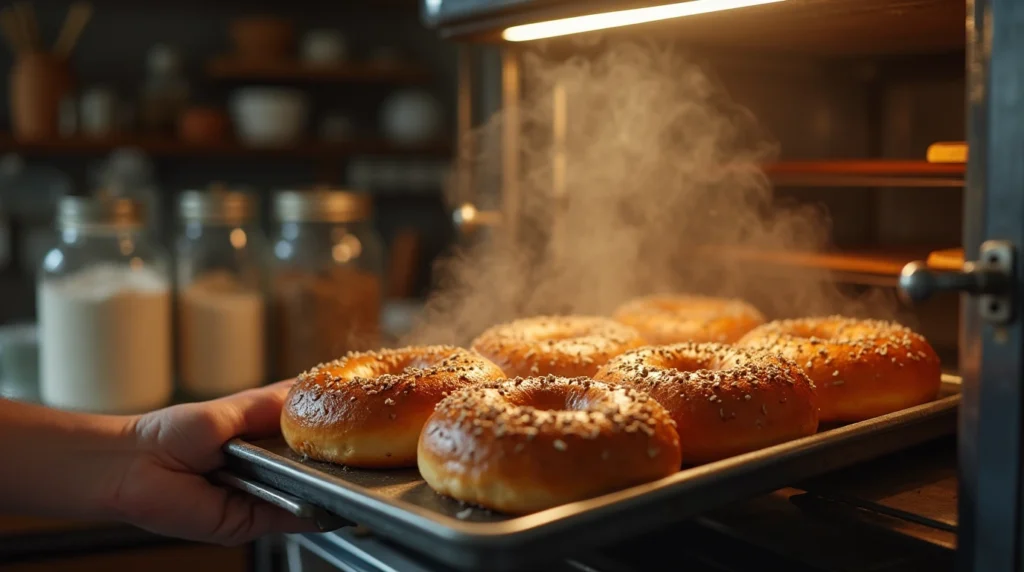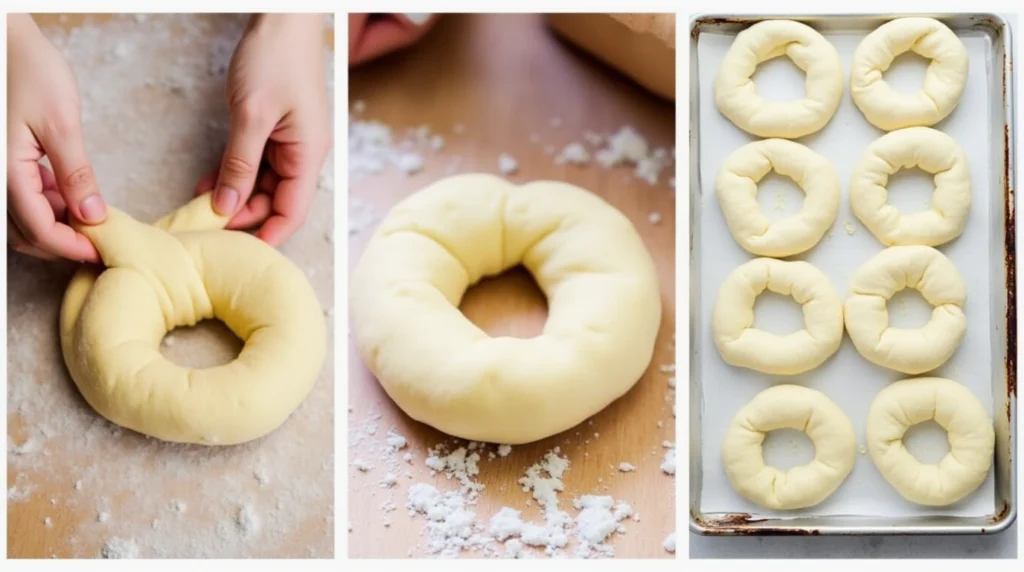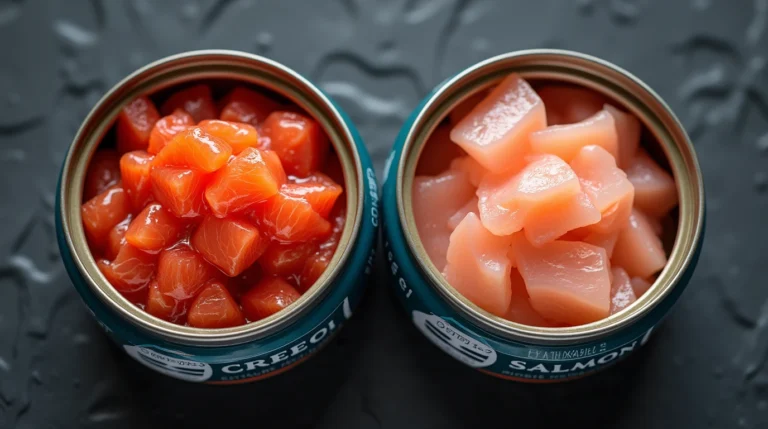Sourdough Bagel Recipe: 3 Easy Steps for Perfect Chewy Bagels
There’s something magical about biting into a freshly baked sourdough bagel – that perfect combination of chewy texture and tangy flavor that can only come from slow fermentation. Whether you’re a seasoned baker or just starting your sourdough journey, this guide will help you create authentic, New York-style bagels right in your own kitchen.

Table of Contents

Sourdough Bagel Recipe
Equipment
- large mixing bowl
- Kitchen scale
- Dough scraper
- Baking sheet
- Parchment paper
- Large pot for boiling
- Spider strainer or slotted spoon
- Cooling rack
Ingredients
For the Bagel Dough:
- 500 g bread flour or all-purpose flour
- 300 g water
- 100 g active sourdough starter 100% hydration
- 10 g salt
- 20 g honey or maple syrup
For the Boiling Solution:
- 2 quarts water
- 2 tablespoons brown sugar
- 1 tablespoon baking soda
Optional Toppings:
- Everything bagel seasoning
- Sesame seeds
- Poppy seeds
- Dried garlic and onion
- Za’atar
Instructions
Day 1: Making the Dough
- Feed Your Starter – Ensure your sourdough starter is active and bubbly, feeding it 8-12 hours before starting.
- Mix the Dough – In a large bowl, combine water, starter, and honey. Then add flour and salt, mixing to form a rough dough.
- Knead the Dough – Knead for 10-15 minutes until smooth and elastic.
- Bulk Fermentation – Cover and let the dough ferment for 4-6 hours until puffy
Shaping and Cold Fermentation
- Divide & Pre-shape – Divide dough into 8 equal pieces and roll into tight balls. Rest for 15 minutes.
- Shape the Bagels – Use the rope method (rolling and sealing ends) or poke method (pressing a hole and stretching).
- Cold Fermentation – Place shaped bagels on a parchment-lined baking sheet, cover, and refrigerate overnight (8-16 hours).
Day 2: Boiling and Baking
- Preheat Oven – Set to 425°F (220°C).
- Boil the Bagels – Bring water to a boil, add brown sugar and baking soda, and boil each bagel for 30 seconds per side.
- Add Toppings – While still wet, coat bagels with desired toppings.
- Bake – Bake for 20-25 minutes until golden brown.
- Cool & Serve – Let cool for at least 30 minutes before slicing.
Notes
- For same-day bagels: Extend bulk fermentation to 8-10 hours and skip the overnight proof.
- For sourdough discard bagels: Use discard with 1 tsp instant yeast for faster fermentation.
- Storage: Keep at room temperature for 2-3 days or freeze for up to 3 months.
- Reheating: Toast or warm in a 350°F oven for 5 minutes.
Why You’ll Love This Sourdough Bagel Recipe
Before we dive into the details, let me tell you why this recipe stands out. These aren’t just any bagels – they’re the perfect marriage of traditional bagel-making techniques and the complex flavors of sourdough. The overnight fermentation develops a deep, tangy flavor that you just can’t get from commercial yeast, while the high-protein flour creates that signature chewy texture we all love.
What Makes These Bagels Special:
- Perfectly chewy texture from proper kneading and boiling
- Complex, tangy flavor from slow fermentation
- Versatile recipe that works with both bread flour and all-purpose flour
- Can be made with active starter or sourdough discard
- Customizable with various toppings
Ingredients
For the Bagel Dough:
- 500g bread flour (or all-purpose flour)
- 300g water
- 100g active sourdough starter (100% hydration)
- 10g salt
- 20g honey or maple syrup
For the Boiling Solution:
- 2 quarts water
- 2 tablespoons brown sugar
- 1 tablespoon baking soda
Optional Toppings:
- Everything bagel seasoning
- Sesame seeds
- Poppy seeds
- Dried garlic and onion
- Za’atar
Equipment Needed
- Large mixing bowl
- Kitchen scale
- Dough scraper
- Baking sheet
- Parchment paper
- Large pot for boiling
- Spider strainer or slotted spoon
- Cooling rack

Step-by-Step Instructions
Day 1: Making the Dough
- Feed Your Starter First things first – make sure your sourdough starter is active and bubbly. Feed it 8-12 hours before you plan to make your dough. You’ll know it’s ready when it doubles in size and has lots of bubbles on the surface.
- Mix the Dough In a large bowl, combine:
- Water (300g)
- Active sourdough starter (100g)
- Honey (20g) Mix well, then add:
- Bread flour (500g)
- Salt (10g)
- Knead and Develop This is where the magic happens. Knead the dough for 10-15 minutes until it becomes smooth and elastic. You’re developing the gluten structure that will give your bagels that perfect chewy texture.
- Bulk Fermentation Place the dough in a clean bowl, cover, and let it ferment at room temperature for 4-6 hours, or until noticeably puffy but not quite doubled.
Shaping and Cold Fermentation
- Divide and Pre-shape Divide the dough into 8 equal pieces (about 115g each). Roll each piece into a tight ball, cover, and let rest for 15 minutes.
- Shape the Bagels There are two methods for shaping sourdough bagels:
Traditional Method:
- Roll each ball into a rope about 8-10 inches long
- Wrap around your hand, overlapping the ends by about 2 inches
- Roll the overlapped area back and forth on the counter to seal
Poke Method:
- Take each ball and press your thumb through the center
- Gently stretch to form an even ring
- Cold Fermentation Place shaped bagels on a parchment-lined baking sheet, cover with plastic wrap, and refrigerate overnight (8-16 hours).
Day 2: Boiling and Baking
- Prepare for Baking
- Preheat your oven to 425°F (220°C)
- Bring a large pot of water to boil
- Add brown sugar and baking soda to the water
- The Boiling Step
- Boil each bagel for 30 seconds per side
- Remove with a slotted spoon and place on a prepared baking sheet
- Add toppings immediately while the surface is still wet
- Bake to Perfection
- Bake for 20-25 minutes, rotating the pan halfway through
- Look for a golden-brown color and firm crust
- Cool on a wire rack for at least 30 minutes before cutting
Tips for Success
- Temperature Matters Keep your dough between 75-78°F (24-26°C) during bulk fermentation for optimal flavor development.
- Flour Choice While bread flour is traditional for sourdough bagels, you can use all-purpose flour. The texture will be slightly less chewy but still delicious.
- Starter Activity Your sourdough starter should be at peak activity when you mix the dough. Look for a starter that’s doubled in size and has a strong, pleasant sour smell.
- Proofing Time The overnight proof in the refrigerator is crucial for flavor development. Don’t skip this step!

Variations
Same-Day Sourdough Bagels
Short on time? You can make these bagels in one day by extending the room temperature fermentation to 8-10 hours and skipping the overnight refrigeration. The flavor won’t be as complex, but they’ll still be delicious.
Sourdough Discard Bagels
Don’t want to wait for an active starter? You can use sourdough discard instead. Simply add 1 teaspoon of instant yeast to compensate for the reduced leavening power.
Vegan Sourdough Bagels
Replace the honey with maple syrup or barley malt syrup for a fully vegan version.
Storage and Serving
Fresh sourdough bagels are best enjoyed within 24 hours but will keep well:
- Room temperature: 2-3 days in an airtight container
- Freezer: Up to 3 months, sliced and wrapped well
To revive day-old bagels, split and toast them, or give them a quick spritz with water and reheat in a 350°F oven for 5 minutes.

Frequently Asked Questions
What is a sourdough starter?
A sourdough starter is the heart of any sourdough recipe. It’s a living culture of wild yeast and beneficial bacteria that develops when flour and water are mixed and allowed to ferment. This culture naturally leavens your bagels while creating that distinctive tangy flavor that makes sourdough so special. Think of it as your own little ecosystem of beneficial microorganisms that will help transform simple ingredients into delicious bagels.
How do I make a sourdough starter?
Creating your own sourdough starter is a simple but patient process:
- Mix equal parts flour and water in a clean jar
- Let it sit at room temperature for 24 hours
- Discard all but 2 tablespoons of the mixture
- Feed with fresh flour and water (equal parts)
- Repeat steps 3-4 daily for 5-7 days until your starter consistently doubles in size and has a pleasant, tangy aroma
How long does it take to make sourdough bagels from scratch?
The total process takes about 15-16 hours, but most of this is hands-off time:
- Initial mixing and kneading: 20-30 minutes
- Bulk fermentation: 4-6 hours
- Shaping: 30 minutes
- Overnight cold proof: 8-12 hours
- Boiling and baking: 45 minutes For a faster option, you can try the same-day method, but the flavor won’t be quite as developed.
What ingredients do I need to make sourdough bagels?
The beauty of sourdough bagels lies in their simplicity. You’ll need:
- Active sourdough starter
- Bread flour (or all-purpose flour)
- Water
- Salt
- Honey or sugar (for both dough and boiling water)
- Baking soda (for boiling water)
Can I use all-purpose flour instead of bread flour?
Yes, you can use all-purpose flour to make sourdough bagels! While bread flour is preferred for its higher protein content (which creates chewier bagels), all-purpose flour will still produce delicious results. The texture will be slightly softer, but they’ll still have that wonderful sourdough flavor. If using all-purpose flour, you might want to reduce the water slightly (by about 20g) as it doesn’t absorb quite as much water as bread flour.
How do I know when my sourdough starter is ready to use?
Your starter is ready when it shows these signs:
- Doubles in size within 4-8 hours after feeding
- Has a dome-like or slightly collapsed top
- Shows lots of bubbles throughout
- Smells pleasantly sour, like yogurt or ripe fruit
- A small amount floats in water (the float test)
How long should I ferment the dough?
The bulk fermentation should last 8-12 hours, depending on your room temperature and starter strength. Look for these signs that fermentation is complete:
- Dough has increased in volume by about 50%
- Surface shows small bubbles
- Dough feels softer and more elastic
- When poked, the dough slowly springs back
Do I have to boil the bagels before baking them?
Yes, boiling is absolutely essential! This step isn’t optional – it’s what gives bagels their distinctive chewy crust and shiny exterior. The brief boiling process gelatinizes the surface starches, creating that characteristic bagel texture that’s impossible to achieve through baking alone. Without boiling, you’d essentially just have round bread.
What do I add to the boiling water?
For the best results, add:
- 2 tablespoons brown sugar or honey (adds color and shine)
- 1 tablespoon baking soda (promotes browning and creates a chewier crust) The alkaline environment created by the baking soda helps develop that beautiful golden-brown color during baking.
What temperature should I bake the bagels at?
Bake your bagels at 425°F (220°C) for 20-25 minutes. You’re looking for:
- A golden-brown exterior
- A firm bottom that sounds hollow when tapped
- Even coloring all around For extra-crusty bagels, you can increase the temperature to 450°F (230°C) for the first 5 minutes, then reduce to 425°F.
How do I store sourdough bagels?
Proper storage is key to maintaining freshness:
- Room temperature: Store in an airtight container for 2-3 days
- Freezer: Slice first, then freeze in an airtight bag for up to 3 months
- Never store in the refrigerator as this accelerates staling To refresh stored bagels, lightly spritz with water and toast or reheat in a 350°F oven for 5 minutes.
What toppings can I use for sourdough bagels?
The possibilities are endless! Popular options include:
- Everything bagel seasoning
- Sesame seeds (white or black)
- Poppy seeds
- Dried garlic and onion
- Za’atar
- Coarse salt
- Caraway seeds
- Grated hard cheese Pro tip: Apply toppings immediately after boiling while the surface is still wet – they’ll stick better!

Troubleshooting Common Issues
- Bagels Are Too Dense
- Cause: Insufficient fermentation or under-kneading
- Solution: Extend bulk fermentation time or knead longer
- Bagels Deflate During Boiling
- Cause: Over-proofed dough
- Solution: Reduce proofing time or temperature
- Uneven Shapes
- Cause: Inconsistent shaping technique
- Solution: Practice the shaping method and ensure even division of dough
- Toppings Don’t Stick
- Cause: Surface too dry or toppings added too late
- Solution: Add toppings immediately after boiling while surface is wet
Conclusion
Making sourdough bagels at home might seem daunting at first, but with this detailed recipe and a bit of practice, you’ll be creating bakery-quality bagels in no time. Remember, the key to perfect sourdough bagels lies in the patience of fermentation and attention to technique. Don’t be discouraged if your first batch isn’t perfect – each time you make them, you’ll learn something new and improve your skills.
Share your bagel-making journey with us! Tag us in your social media posts or leave a comment below with your experience and any questions you might have. Happy baking!
Write a review
There are no reviews yet. Be the first one to write one.







